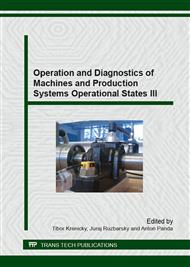[1]
P. Beraxa, Ľ. Parilák, M. Ulbrichtová, Increasing Service Life of Tools by CVD Coating, Hutnicke listy 3 (2010) 37-41.
Google Scholar
[2]
T. Burakowski, T. Wierzchon, Engineering of metal surface (Inżynieria powierzchni metali) WNT, Warsaw (1995) (in Polish).
Google Scholar
[3]
R. Cep et al., Surface roughness after machining and influence of feed rate on process, Key Engineering Materials 581 (2014) 341-347.
Google Scholar
[4]
B. Kaczmarska, W. Gierulsky, S. Luscinski, The Issue of Reducing the Expectations Gap in Implementing of MRP, Manufacturing and Industrial Engineering 4/9 (2012) 38-40.
Google Scholar
[5]
J. Marciniak, Z. Paszenda, Biotolerance metallic biomaterials: Splondyloimplantologia advanced treatment of spinal DERO system, Polish DERO group, the Association of study and research of the spine, 2004, pp.133-142.
Google Scholar
[6]
J. Mihok, J. Markovič, Importance of planning as a core function of strategic management, Management of Companies (Manažment podnikov) 3/2 (2013) 57-58.
Google Scholar
[7]
A. Mlynarczak, A. Piasecki, Aluminizing diffusion of titanium, Materials Engineering 4 (2010) 1104-1106.
Google Scholar
[8]
A. Mlynarczak, Modifying the structure and properties of mono- and multi-layer diffusion of chromium carbides of titanium and vanadium steels manufactured by powder, Poznan University of Technology, Lectures, (2005).
Google Scholar
[9]
A. Panda, J. Duplák, J. Jurko, J. Zajac, Turning bearing rings and determination of selected cutting materials durability, Advanced Science Letters 19/8 (2013) 2486-2489.
DOI: 10.1166/asl.2013.4943
Google Scholar
[10]
T. Krenický, Implementation of Virtual Instrumentation for Machinery Monitoring, in: Scientific Papers: Operation and Diagnostics of Machines and Production Systems Operational States: Vol. 4, RAM-Verlag, Lüdenscheid, 2011, pp.5-8.
Google Scholar
[11]
B. Rusinek, A. Stobicka, K. Obtułowicz, Allergy and titanium implants, Allergology - Immunology 5/1 (2008).
Google Scholar
[12]
U. Sen, S. Pazarlioglu, S. Sen, Niobium boride coating on AISI M2 steel by boro-niobizing treatment, Materials Letters 62 (2008) 2444–2446.
DOI: 10.1016/j.matlet.2007.12.042
Google Scholar
[13]
T. Wierzchon, E. Czarnowska, D. Krupa, Surface engineering in the production of titanium biomaterials, PW Publishing House, Warsaw, (2004).
Google Scholar


